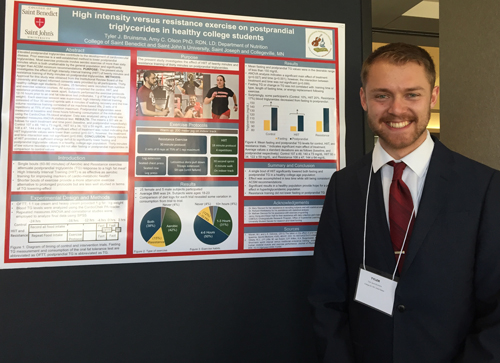CSB and SJU undergraduate research scores at ACSM meeting
April 24, 2017
By Mike Killeen

Front row from left: Morgan Potter, Allison Kosobud, Molly Heller
Back row from left: Tyler Bruinsma, Meghan Koop, Ben Hodapp

Tyler Bruinsma stands by his poster.
Three students from the College of Saint Benedict and Saint John’s University placed first, second and fifth among 57 undergraduate students at the Northland Chapter of the American College of Sports Medicine (ACSM) spring meeting.
All three — Tyler Bruinsma (first), Molly Heller (second) and Meghan Koop (fifth) — are individualized natural science-integrative health science majors.
The meeting, held April 7 at St. Catherine University in St. Paul, Minnesota, included college students from Minnesota, Wisconsin, North Dakota, South Dakota and Nebraska.
Bruinsma, a senior from Rochester, Minnesota, finished first with his poster, “High intensity versus resistance exercise on postprandial triglycerides in healthy college students.” His adviser was Amy Olson, professor of nutrition at CSB and SJU.
Elevated postprandial triglycerides contribute to the development of cardiovascular disease. Exercise is a well-established method to lower postprandial triglycerides, but most exercise protocols involve aerobic exercise of more than 60 minutes, which is unattainable by the general population and significantly longer than ACSM minimum recommendations.
Bruinsma’s research investigated the effect of high intensity training of 20 minutes and resistance training of 30 minutes on postprandial triglycerides.
He received $350 for placing first, and will present his research at the ASCM national meeting May 30-June 3 in Denver.
Heller, a senior from Belleville, Wisconsin, finished second with her poster, “Validity of Fitbit charge in college students during free-living conditions.” Her advisers were Mary Stenson, associate professor of exercise science and sport studies, and Donald Fischer, associate professor of exercise science and sports studies.
Hip-worn Fitbits are a valid measure of step counts and energy expenditures in middle-aged populations, but the validity of the new wrist-worn Fitbit Charge has not been established. Heller’s study was to determine the validity of the Fitbit Charge in estimating step count and caloric expenditure in a college population during free-living conditions.
Heller received $250 for placing second.
Koop, a senior from Roseville, Minnesota, placed fifth with her poster, “Effects of snacks during volleyball practice on blood glucose levels and performance.” Her adviser was Olson.
The volleyball team provides a variety of sideline snacks for players to maintain energy throughout a match. Carbohydrate supplementation improves endurance performance, but the results are mixed for intermittent sports performance. Koop’s study examined how various snacks affect blood glucose levels for players during practice.
Koop received $50 for placing fifth.
The students started their research during the spring semester of their junior years, according to Stenson.
“We are very proud of all our research students and the incredible work they have accomplished,” Stenson said. “Really, they are doing graduate-quality research at an undergraduate level. Their projects are high quality and very time intensive, so it’s a real pleasure to see them present their findings at a professional conference,”
Three other students had their research displayed at the conference — Ben Hodapp (senior, Duluth, Minnesota), Allison Kosobud (senior, Nisswa, Minnesota) and Morgan Potter (senior, Apple Valley, Minnesota).
